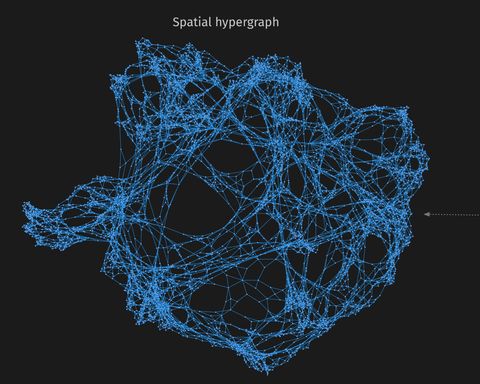Talks
Guest lecture | University of Bergen | 29.10.2024
The notion of a "space of reasons" is a metaphor that was made popular by Wilfrid Sellars. This talks offers a novel interpretation of this metaphor through the mathematical instrument of a hypergraph.
Hypergraphing the space of reason
Following a suggestion by Wolfram (2021) indicating that the concept of space can to be reconceived like we can get underneath the concept of water by modelling its constituents, I offer an interpretation of the space of reason through the mathematical instrument of a hypergraph.
We orientate ourselves in decision making spaces, problem spaces, debates, bodies of texts, by way of argument. One function central to argument is cognitive coordination of participants in shared sense-making practices (Stovall 2025). Now, if the concept of space itself is a metaphor presupposed for coordination of action, perception and thinking, we can re-describe movements in the space of reason if we can get underneath the concept of space. Sellars suggested that the key to giving metaphysics its truly scientific turn lies in understanding the significance of the method of projection (Sellars 1968, SM preface vii). To date, little clarity was to be gotten out of a claim central to his metaontological position that objects may turn out to be virtual classes (Sellars 1968 V §99, V §53, cf. Dach 2025).
I offer a characterisation of steps in the space of reason as argument map based movements along contextually confined paths. In doing so, I (1) present an interpretation of the very idea of a virtual class as dependent notion presupposing the combination of a chosen method of projection and a vectorised path dependency within a context. If this goes through, this shows that the idea of objecthood can itself be dynamised, allowing for ranges of objects displaying degrees of abstractness. Some objects are concrete, others more abstract. (2) Given a hypergraph modeling frame, argumentative modalities of movement, establishing possible, real, necessary connections between points (to be made) rest on frames. Different moves are constraint by different frames. To project from one area into another then is to move from one frame to another frame. (3) A ‘conceptual scheme’ can then be defined as sub-area of the hypergraph that stands as a contextual boundary for projecting classes of objects. I close by deriving consequences for Metaphysics arguing that the drive of metaontology is to get behind cross framework principles binding for all sorts of object conceptions.
Literature
Dach, Stefanie (2025) - Wilfrid Sellars on Truth. Between Immanence and Transcendence. New York: Routledge.
Seiberth, Luz Christopher (2025) - Sellars’ Metaontology, in Ranae & Seiberth, Reading Kant with Sellars: Reconceiving Kantian Themes. New York: Routledge, 251-277.
Sellars, Wilfrid (1968) - Science and Metaphysics. London: Paul Kegan.
Stovall, Preston & Ladislav Koreň (2025) - Why and How We Give and Ask for Reasons. Oxford: Oxford University Press.
Wolfram, Stephen & Sean Carroll (2021) "Stephen Wolfram on Computation, Hypergraphs, and Fundamental Physics", [mindscape 155]
